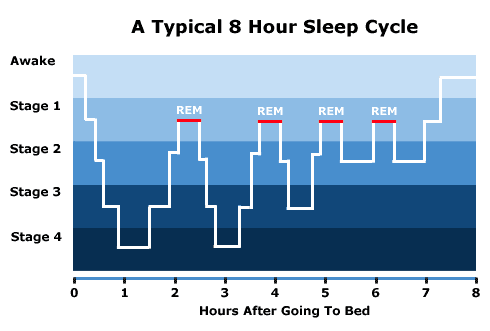A third of our lives are spent sleeping. What actually happens while we sleep?
a. Activity in the brain comes to a near halt, allowing for necessary rest and recovery
b. The brain busily progresses through cycles adjusting brain wave activity throughout the night
c. We control the content of our dreams, subconsciously acting out our goals and desires
Answer:
b. The brain busily progresses through cycles adjusting brain wave activity throughout the night.
Far from going dormant, each night as you fall asleep, your brain remains quite active. Without any effort on your part, your brain goes through 4-5 cycles of sleep, each with distinct stages that fulfill critical physiological and neurological functions for the health of your body and mind.
A sleep cycle lasts 90-110 minutes and includes four stages of sleep. These stages are defined primarily by electrical patterns known as brain waves. And while unique and important activity occurs during each stage of sleep, the boundaries between the stages are rather blurred and continuous.
Sleep Stages
Non-REM Stage 1:
This is the stage between wakefulness and sleep. In it, muscles are still quite active and the eyes roll around and may open from time to time. Breathing becomes more regular and heart rate slows. While dreaming during this stage is rare, often, sudden twitches or jerks can occur. This is a time of light sleep that can easily be disrupted.
As far as brain activity goes, Stage 1 is a period of transition from relatively unsynchronized and higher frequency gamma and beta brain waves to more synchronized, but lower frequency, alpha and then theta waves. The actual point of falling asleep is difficult to pinpoint since the process is a continuum as brain wave activity gradually slows.
Stage 1 represents just 5% of total sleep time.
Non-REM Stage 2:
Muscle activity decreases in Stage 2 and conscious awareness of the outside world fades. Brain waves are mainly in the theta wave range but sleep spindles (short bursts of brain activity) and K-complexes (unique and brief waveforms) occur to protect sleep and suppress outside stimuli. The sleep spindles and K-complexes also aid in memory consolidation and information processing. This stage represents 45-50% of total sleep time and maybe more for young adults.
Non-REM Stage 3:
Known as deep or slow-wave sleep, Stage 3 consists primarily of lower frequency and more synchronized delta brain waves. In it, the sleeper is essentially cut off from the world and unaware of any sounds or outside stimuli. Brain temperature, breathing rate, heart rate and blood pressure are all at their lowest now. Dreaming can occur in Stage 3, but it is less vivid than in REM sleep and likely not remembered. But this is the stage when night terrors, sleep-walking, sleep-talking and bedwetting occur. Information processing and memory consolidation (particularly of facts, ideas and experiences) take place during this period.
Stage 3 sleep represents 15-20% of total adult sleep time and occurs in longer periods during the first half of the night (especially the first two sleep cycles). Children and young adults have more Stage 3 sleep than adults, while older adults may experience little or no Stage 3 sleep at all. In fact, researchers are studying the connection between the twin complaints of poor sleep and declining memory in the elderly.
REM Sleep Stage:
Associated with rapid and random side-to-side movements of the closed eyes, REM sleep is a time of dreaming. Brain waves are similar to those experienced during the waking state and include theta, alpha and even high frequency beta waves (more associated with high-level thinking and concentration). Breathing is more rapid and irregular during REM and heart rate and blood pressure increase to near waking levels. In REM sleep, the muscles become completely paralyzed and unresponsive.
REM sleep is important for learning complex tasks. This is critical in early childhood development when REM sleep makes up a much larger percentage of total sleep. Memory consolidation of procedural and spatial memory takes place during this stage. Following days of learning new tasks or being put in unusual situations, people spend more time in REM sleep.
Sleep Cycles:
A sleep cycle progresses from gamma and beta waves of wakefulness through alpha and theta waves to the delta waves of slow-wave sleep and back again as displayed in the chart depicting five sleep cycles. Non-REM Stage 1 and REM sleep are the easiest to awaken from since brain activity during those stages is closest to waking. In contrast, if a person is awakened from Non-REM Stage 3, they will feel very groggy and it may take up to 30 minutes to attain normal mental performance.
Night awakenings typically occur between sleep cycles either due to a dream or simply because the pattern of your brain waves approaches your awake state. When your brain becomes too active, it can become difficult to quell your thoughts and start the next sleep cycle. Many people find that getting back to sleep is helped by using the Dreampad and setting the music to play throughout the night as the calming vibrations ease the transition back into lower frequency brain activity.
For more resources on sleep, read the Dreampad blog.




 © 2025 Unyte Health US Inc.
© 2025 Unyte Health US Inc.